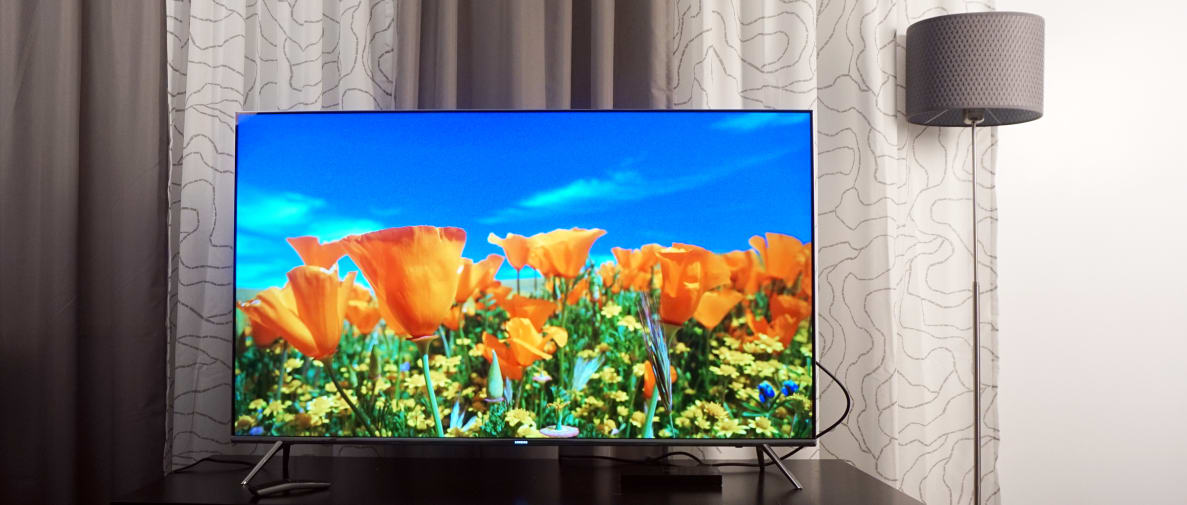These TVs boast High Dynamic Range compatibility, "quantum dot" enhanced color, and 4K/UHD resolution to deliver oodles of brightness, color, and sharpness (compared to whatever TV you've likely got now, at least). Essentially, the KS8000 is the spiritual successor to last year's JS8500 (at least in terms of its flat screen), and it's already proving to be one of Samsung's most popular models.
Samsung's KS8000 is an outstanding option if you're looking for bright, colorful HDR performance and don't mind giving up the advantages of full-array local dimming. While its edge-lit design occasionally creates shadow tone aberrations, it's an otherwise stellar performer dressed in a sleek silver suit and polished to a sheen. With every size clocking in under $2,000 right now, this is one of the most affordable 4K HDR TV series we've seen.
About the KS8000 Series
Samsung's KS8000 series is available in four screen sizes:
• 49-inch (Samsung UN49KS8000), $1,099 (MSRP $1,799) • 55-inch (Samsung UN55KS8000), $1,299 (MSRP $2,199) • 60-inch (Samsung UN60KS8000), $1,499 (MSRP $2,799) • 65-inch (Samsung UN65KS8000), $1,799 (MSRP $3,499)
{{ amazon name="Samsung UN55KS8000 (2016 Model)", asin="B01C5TFLSE", align="right" }}
As you can see, each of the KS8000 TVs has experienced a considerable drop in price since the beginning of the year, although it's also safe to argue that the MSRPs may have been inflated a bit to complement the feeling that you're saving a bunch of these TVs. But even still, as one of Samsung's premium "SUHD" series, these prices are all pretty solid.
Here are the key shared specs between the four models:
• 4K (3,840 x 2,160) resolution • High Dynamic Range compatibility (HDR10, no Dolby Vision) • Quantum Dot color • 1,000 nit HDR reference • Edge-lit LED backlight • 4 x HDMI; 3 x USB inputs (One Connect)
The KS8000 series doesn't boast all the same premium trimmings as the upscale KS9500 or KS9800 models, but it's nevertheless kitted out in a robust manner. The notable takeaways for the KS8000 (compared to the rest of Samsung's 2016 SUHD lineup) is that it's not curved and doesn't use a full-array LED backlight like the flagship KS9800.
We purchased our 55-inch KS8000 (UN55KS8000) from Amazon, and as usual gave it about 24 hours of warm up/settle time prior to testing and evaluation. I spent about a week with the TV, watching movies & TV; playing games; and digging into the performance via light and color meters.
Pros & Cons
Pro: This is a sleek, modern, sexy product—and that's purely a bonus.
The KS8000 TVs aren't perfect from a performance standpoint, but they do deliver an impressive array of enhanced picture attributes, like super-bright HDR luminance and rich color fidelity (more on that in a bit). The icing on the cake? They also just look great, as far as TVs go.
The KS8000 TVs aren't what we'd call "cheap," but they're affordable for everything they offer. By that logic, it's kind of an additional bonus to get such sleek design at this price. Sturdy, silver bezels grace the screen and stand (unless you go for the Costco-exclusive KS800D, which is more of a black/gunmetal style) and do double duty where style and reliability are concerned.
{{ photo_gallery "design" }}
The space-saving "feet" stand, thin profile, and smooth rear chassis combine to great effect here. It's also definitely worth noting that the assembly process is a breeze: No screws are required, you just pop the feet into the bottom of the TV. Easy!
Finally, the remote—while super simplified as usual—is a perfectly useful tool, while still maintaining the TV's air of minimalism. The KS8000 TVs also include Samsung's "OneConnect," which externalizes the HDMI, USB, and optical ports via a compact and easily stow-able cabled box.
Pro: In most viewing environments, the picture quality is great.
The KS8000's biggest performance hurdle comes in the form of its its "edge-lit" backlight, which is how it primarily differs from the ultra high-end KS9800 flagship. With this kind of backlight, LEDs line the edges of the screen only, while a full-array backlight puts LEDs behind the entire screen.

This is Movie mode, post-calibration (after being calibrated). It looks excellent even in a darker viewing environment.
Because edge-lit TVs rely on LEDs installed around the perimeter to provide light for the entire screen, they look better when the backlight is brighter than when it's dimmer. This means the KS8000 looks great in normal environments or rooms with more ambient light (windows, lamps) than average, but can look uneven when attempting to operate in dimmer/darker environments where the backlight is set much lower. This is not an issue when watching HDR content, however.

Movie mode looks great, but with Samsung's "HDR+" Special Viewing Mode (in the picture menu), you can add extra color and brightness to non-HDR content without losing detail. It's an awesome way to spruce up non-HDR content.
There can be occasional issues with backlight uniformity, but surprisingly the KS8000 is mostly pretty spotless. I was impressed with the consistency of shadow luminance and highlights, and the lack of "flashlighting" and hot spots during dark, filmic scenes. Not only is it calibrated well out of the box in terms of core staples like white balance and color accuracy, but its 4K resolution and quantum dot enhancements give it a serious edge. Especially if you're moving from a non-4K, standard dynamic range set, you're definitely going to be impressed by the KS8000 series.

Native 4K footage looks great too. You can enjoy sloths in almost any form on the KS8000!
Con: A limited viewing angle makes wall-mounting risky.
The KS8000's biggest drawback is its viewing angle, which is very limited. Because it uses LED dimming to control and mitigate its backlight brightness and shadow quality, the KS8000's light effusion falls off quickly when you move to the left or right (or up/down) from head-on viewing.

One of the KS8000's only drawbacks is its limited viewing angle. If you watch from too far off center, you lose brightness and color saturation.
I measured a very narrow total viewing angle of 16°, or ±8° from the center to either side. This means from 10 feet, you can only move about a foot-and-a-half in either direction before contrast starts to degrade. This is okay for groups on a couch, but it's not great for would-be wall-mounters.
Pro: Color and brightness that'll blow you away.
There's no arguing that outside of OLED's intrinsic saturation, quantum dots are the best thing to happen to TV color since, well, color TV. The difference in the old color standard for HDTV and the new "DCI-P3" color space aimed at by HDR TVs is striking.

The KS8000's "quantum dot" enhanced color makes reds and greens look especially impressive, and helps it cover the coveted DCI-P3 wide color gamut.
Quantum dot-powered greens and reds (and by relation, cyans, magentas, and especially yellows) are simply a sight to behold, as usual. This is one area where the KS8000 performs almost as mightily as much pricier quantum dot sets, like the flagship Samsung KS9800.
The efficacy of quantum dots is in part tied to a TV's brightness, which is another area where the KS8000 really—cringe—shines. While it may not have the backlight uniformity and shadow depth of a non edge-lit set, it's every bit as capable of pumping out oodles of brightness.
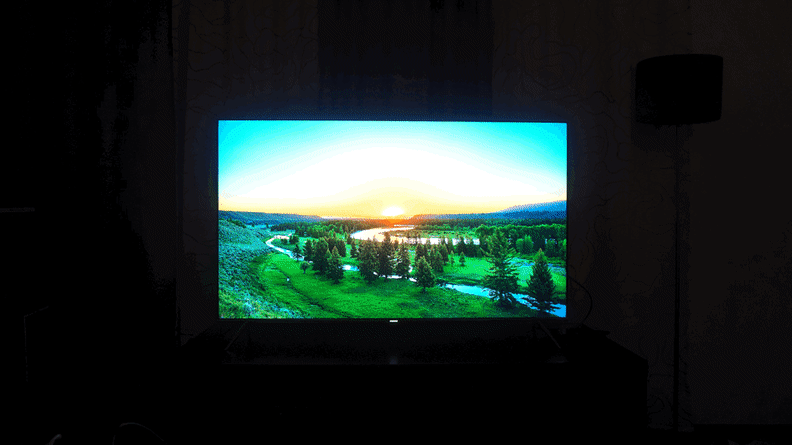
While this is optimized Samsung demo material, it shows off the KS8000's impressive peak brightness, which is especially good for an edge-lit TV.
I measured non-sustained speculars that excursed above 1300 nits (specifically, 1394 at 2%; 1378 at 5%; and 1376 at 10%) with sustained levels evening out around 500-700 nits. To put it in plain english, this TV is every bit as bright as Samsung's flagship model—and just as colorful. TV nerds: check its DCI-P3 coverage on the science page.
Con: While watching HDR, black levels suffer—technically.
First things first: the KS8000 TVs are stellar options for contrast when you're not watching SDR. Using the standard ANSI checkerboard pattern in Movie mode (standard dynamic range), I measured black levels between 0.035–0.045 and reference luminances around 250 nits, both of which are excellent results, especially for an edge-lit LED TV like this.
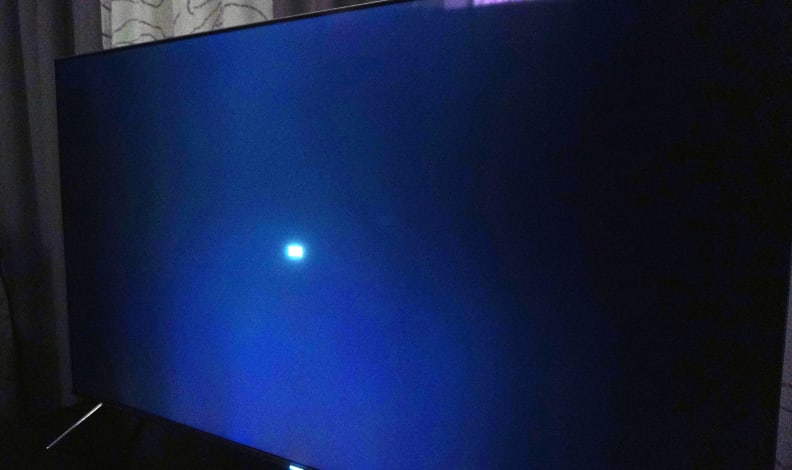
While this is obviously QUITE exaggerated via Photoshop, this is one example of an HDR specular drawing so much power as to disrupt shadow uniformity in dark areas of the screen.
However, the contrast changes a bit when HDR is enabled. Because the KS8000 is so bright, its black levels suffer on a technical level, jumping up around 0.1 nits once the reference brightness hits around 500 nits or higher. However, it's very important to note that for most HDR content, the sheer brightness means your eye won't be resolving much detail below around 0.1 nits anyway. This is definitely an edge-lit related drawback, but it's in no way a drastic one.
Pro: Where motion is concerned, the KS8000 is a solid choice.
Every TV in the KS8000 series has a 120 Hz native refresh rate. Of the two native refresh rates for modern TVs—60 and 120 Hz—the latter is the one you usually want. 120 Hz TVs are superior due to their ability to play content that plays at 24 frames per second—which is most movies and films, particular Blu-ray discs—without visible judder, something 60 Hz TVs literally cannot do.

The KS8000 also does a really good job upscaling sub-4K content (like this 1080p, SDR Netflix movie) without artifacts or oversharpness.
As you might have guessed, the KS8000 TVs are all 120 Hz options. This means they play Blu-rays and 24fps content smoothly, with no judder. Samsung also includes its Auto Motion Plus mode for reducing judder and blur in 30/60p or higher content, which can help reduce trailing in content like sports. Overall, there's nothing to complain about from a motion performance standpoint.
Pro/Con: The menu and smart functions are fine, not a reason to buy.
Last but not least, the final component of this TV is its menu interface and smart features. Overall, Samsung's interface has received some nice updated features compared to last year's iteration. The menu still puts major focus on the screen, listing items along the lower fourth and keeping most of the screen free of clutter when you access it.
The smart functions are an easy way to access key apps like Netflix, Amazon Instant, and YouTube—all of which also offer 4K/HDR footage. However, most additional apps/games are still shovelware, and using the stock browser with the minimalist smart remote is a real pain.
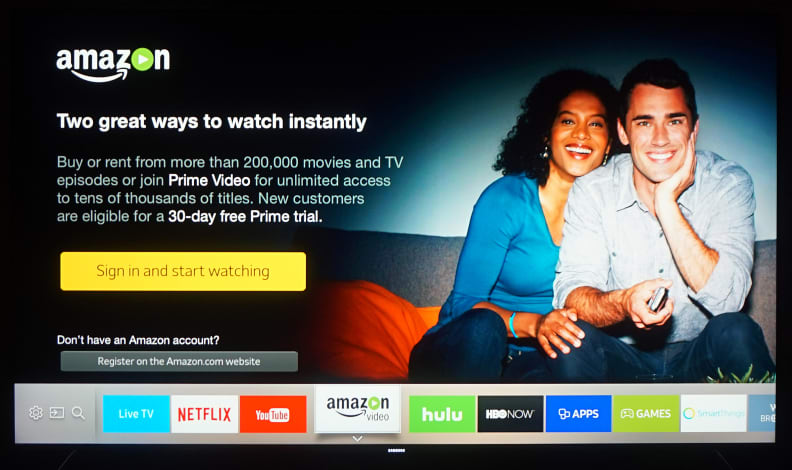
Samsung's smart features and interface are sleek and easy to use. I still prefer options like Roku for streaming, however.
Should You Buy It?
Yes—especially if you primarily want a great 4K/HDR TV.
The KS8000 TVs are some of the first I've tested in this price range that felt like HDR TVs first and foremost. By that I mean, Samsung's KS8000 series delivers more than enough ample and color to deliver HDR content that's on-par with OLEDs and flagships you'd pay thousands more for.
On the other hand, the TV's edge-backlight and lack of local dimming makes it a little less fetching as a general, all-purpose display compared to some of the competition. You won't have any complaints when you're watching HDR content or simply using the awesome "HDR Plus" picture mode, though.
Bottom line: If you're looking specifically for a subtle, dark theater room display, the KS8000 series might not be the top choice. But for everyone else, it's an awesome way to get stellar HDR and 4K performance without spending a bundle, and is one of the year's best values in its price range.
Calibration & Test Results
In terms of standard dynamic range, the KS8000 is an excellent core performer. In the Movie mode default, it exhibited excellent color production, and acceptable levels of error within its grayscale production (dE) and RGB emphasis.
The TV's gamma production both pre- and post-calibration was imperfect, but not bad considering the TV's use of boosting/dimming LEDs designed for super-bright HDR performance. Most importantly, the relatively affordable KS8000 TVs cover almost 100% of the DCI-P3 color gamut when playing HDR content (or in the "HDR Plus" mode).
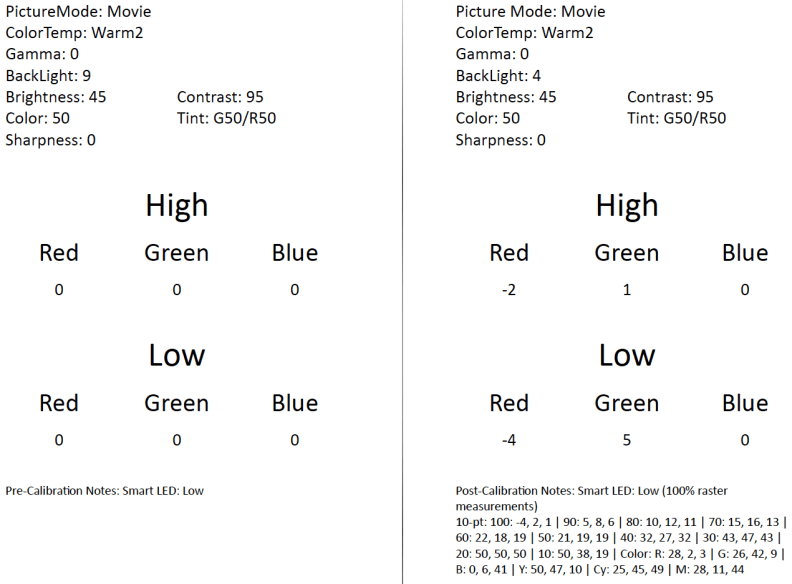
I calibrated the KS8000 using full-field 100% rasters and leaving the Smart LED setting on Low. The before-and-after results below speak for themselves.
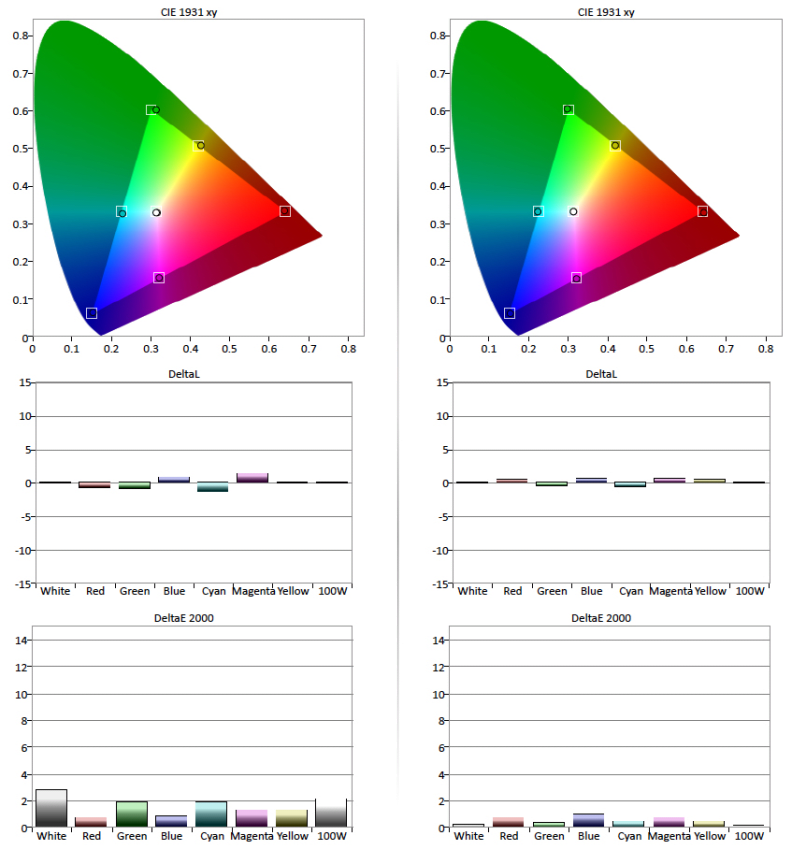
The KS8000's out-of-box color accuracy and gamut luminance in Movie mode was already very accurate, but with calibration I was able to make small improvements to the overall color representation.
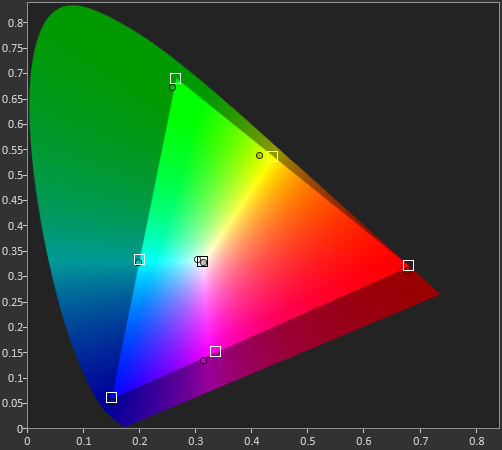
The KS8000 almost covers the entire DCI-P3 wide color gamut, thanks to its quantum dot enhanced color production.
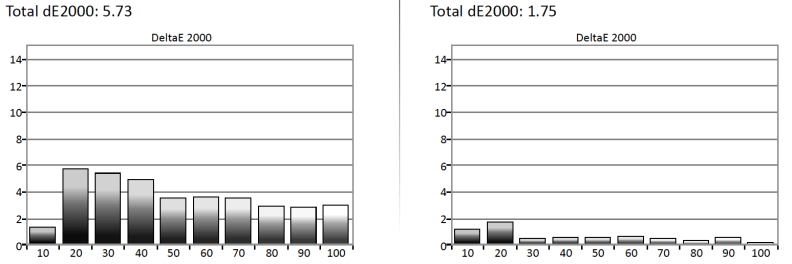
The KS8000's red push in lower IREs created some higher-than-ideal grayscale dE in the out-of-box Movie mode. After calibration, it's perceptibly perfect.
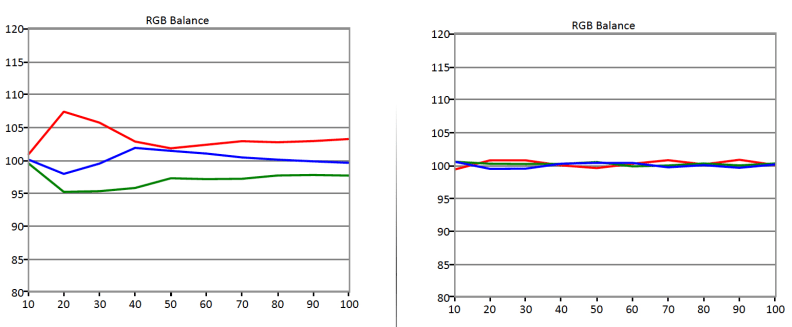
The KS8000's RGB emphasis certainly wasn't perfect out of the box, but it also wasn't too off the mark where perceptible white balance shifts are concerned (the low IRE red push was definitely visible, however).
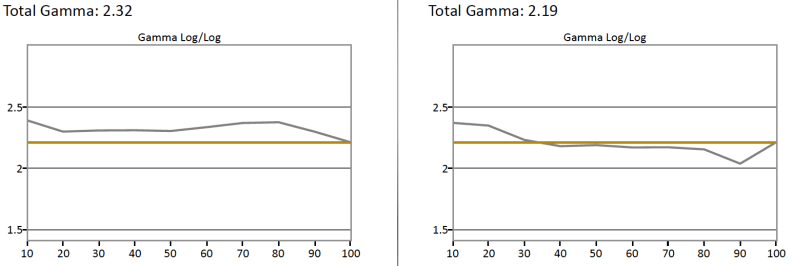
Both the pre- and post-calibrated gamma settings for the KS8000 aren't perfect, but both are pretty good for a TV using scaling dimming algorithms to adjust to IRE level.
Meet the testers
Mark Brezinski works on the Home Team, reviewing refrigerators, minifridges, dishwashers, washing machines, dryers, air conditioners, air purifiers, and fans.
Lee was Reviewed's point person for most television and home theater products from 2012 until early 2022. Lee received Level II certification in TV calibration from the Imaging Science Foundation in 2013. As Editor of the Home Theater vertical, Lee oversaw reviews of TVs, monitors, soundbars, and Bluetooth speakers. He also reviewed headphones, and has a background in music performance.
Checking our work.
Our team is here for one purpose: to help you buy the best stuff and love what you own. Our writers, editors, and lab technicians obsess over the products we cover to make sure you're confident and satisfied. Have a different opinion about something we recommend? Email us and we'll compare notes.
Shoot us an email

